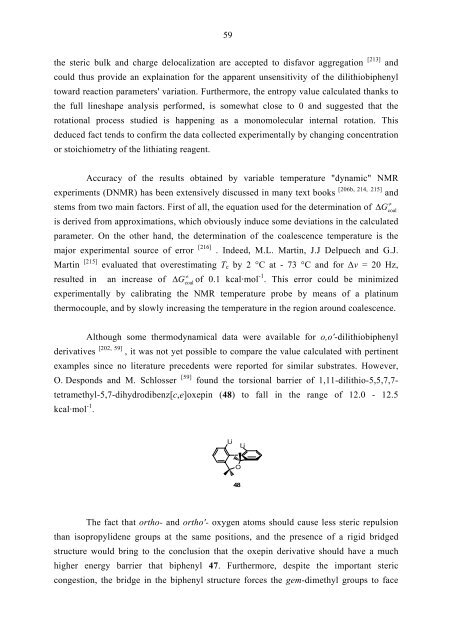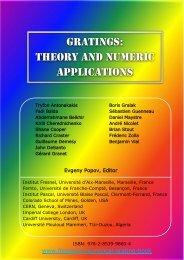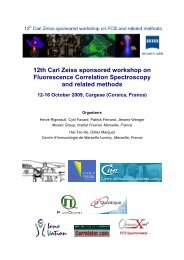My PhD dissertation - Institut Fresnel
My PhD dissertation - Institut Fresnel
My PhD dissertation - Institut Fresnel
Create successful ePaper yourself
Turn your PDF publications into a flip-book with our unique Google optimized e-Paper software.
the steric bulk and charge delocalization are accepted to disfavor aggregation<br />
59<br />
[ ] 213 and<br />
could thus provide an explaination for the apparent unsensitivity of the dilithiobiphenyl<br />
toward reaction parameters' variation. Furthermore, the entropy value calculated thanks to<br />
the full lineshape analysis performed, is somewhat close to 0 and suggested that the<br />
rotational process studied is happening as a monomolecular internal rotation. This<br />
deduced fact tends to confirm the data collected experimentally by changing concentration<br />
or stoichiometry of the lithiating reagent.<br />
Accuracy of the results obtained by variable temperature "dynamic" NMR<br />
experiments (DNMR) has been extensively discussed in many text books [206b, 214, 215] and<br />
stems from two main factors. First of all, the equation used for the determination of<br />
is derived from approximations, which obviously induce some deviations in the calculated<br />
parameter. On the other hand, the determination of the coalescence temperature is the<br />
major experimental source of error<br />
≠<br />
∆Gcoal [ 216 ]<br />
. Indeed, M.L. Martin, J.J Delpuech and G.J.<br />
Martin [215] evaluated that overestimating Tc by 2 °C at - 73 °C and for ∆ν = 20 Hz,<br />
≠<br />
-1<br />
resulted in an increase of G of 0.1 kcal·mol . This error could be minimized<br />
∆ coal<br />
experimentally by calibrating the NMR temperature probe by means of a platinum<br />
thermocouple, and by slowly increasing the temperature in the region around coalescence.<br />
Although some thermodynamical data were available for o,o'-dilithiobiphenyl<br />
derivatives [202, 59] , it was not yet possible to compare the value calculated with pertinent<br />
examples since no literature precedents were reported for similar substrates. However,<br />
O. Desponds and M. Schlosser [59] found the torsional barrier of 1,11-dilithio-5,5,7,7-<br />
tetramethyl-5,7-dihydrodibenz[c,e]oxepin (48) to fall in the range of 12.0 - 12.5<br />
kcal·mol -1 .<br />
Li<br />
O<br />
48<br />
Li<br />
The fact that ortho- and ortho'- oxygen atoms should cause less steric repulsion<br />
than isopropylidene groups at the same positions, and the presence of a rigid bridged<br />
structure would bring to the conclusion that the oxepin derivative should have a much<br />
higher energy barrier that biphenyl 47. Furthermore, despite the important steric<br />
congestion, the bridge in the biphenyl structure forces the gem-dimethyl groups to face













